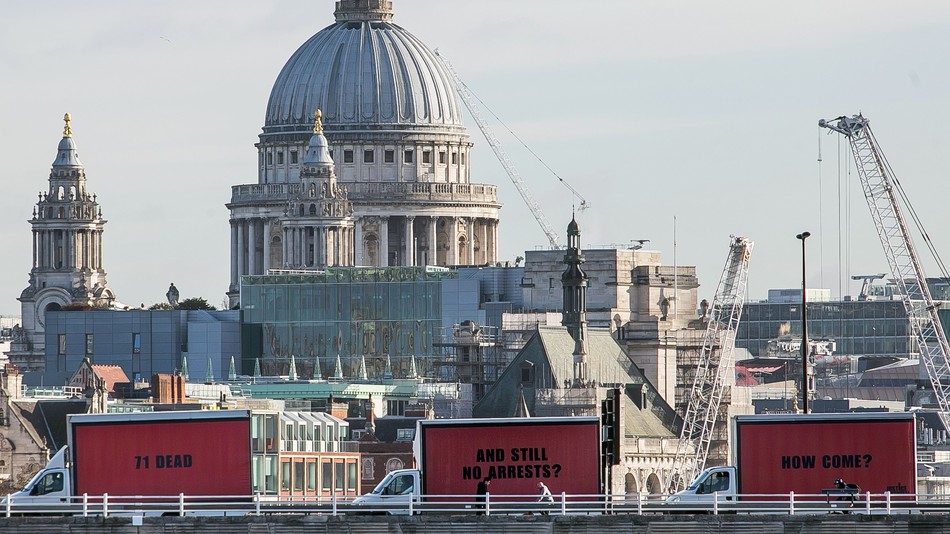It’s no secret that art is inspired by real life. Arguably, all forms of creativity are derived from experience, whether knowingly or subconsciously. But what about the other way round? As once coined by Oscar Wilde, ‘Life imitates art far more than art imitates life’. And in light of the recent public events á la Three Billboards Outside Ebbing, Missouri, newly BAFTA’s Best Film, we can see art inspiring not only real life, but the seizure of pertinent political issues by the public.
In a rebuttal after progress in the Grenfell Towers investigation has waned, the activist group Justice4Grenfell has paraded three vans around central London, emblazoned with the words: ’71 DEAD, AND STILL NO ARRESTS? HOW COME?’ Backed by ad agency BBH Labs, the signs took the same colour scheme and font type directly from the film, hoping to underline the stagnation regarding the justice promised to Grenfell victims. The protest mirrors that of Frances McDormand, who in the film erects three billboards asking similarly provocatively blunt questions as to the efforts of local police concerning her daughter’s murder.
Justice4Grenfell spokesperson Yvette Williams said the film “highlights the power of advertising to bring about justice. We wanted to harness this power to remind people how little has been done since the tragic event shook this community, and the country, just over 8 months ago.” She continued, “These billboards are here because there have still been no arrests, hundreds of survivors remain homeless, and 297 other towers in the UK are covered in flammable cladding.”

A parallel protest has appeared on the A38 in Bristol, questioning the state of the NHS. The street art mural, installed by People’s Republic of Stokes Croft and organised by the Bristol group Protect Our NHS, depicts three red billboards and asks, ‘OUR NHS IS DYING, AND STILL NO MORE FUNDING, HOW COME, MRS MAY?’ with text below reading ‘THE ROAD TO PRIVATISATION’. This emulation of the three billboards has not just been confined to Britain. The same idea of adverts on vans, as in London, has occurred around Miami. They target Senator Marco Rubio over his maintained inaction on gun control since the Florida school shooting, in which 17 were killed by a gunman on February 14. The boards read: ‘SLAUGHTERED IN SCHOOL, AND STILL NO GUN CONTROL? HOW COME, MARCO RUBIO?’ and were arranged by online activist group Avaaz.
An interesting thing to note is that despite attaining a plethora of BAFTAs and being Oscar-nominated, Three Billboards Outside Ebbing, Missouri, is not a mainstream, blockbuster film in the same way that something like Star Wars is, and so many people who observe these responses may not get the reference. Yet, this is almost irrelevant, as it does not detract from the motives of the billboards. As the character of Mildred Hayes proclaimed in the film, the purpose was to keep the injustice in the public eye.
Good films are emotionally charged, and produce a passionate response to the subject content. Film may prompt reality by allowing a viewer to see something of themselves or their life in the characters and events depicted in the film, and make an association which then spurs real life action. Today more than ever, there is worldwide discontent with the performance of authorities, particularly in answer to humanitarian disasters such as government response to working classes in the UK, and gun crime in America. And in the current political climate, arts are playing an increasingly crucial role as we see pop culture deployed in the interest of public welfare on the streets.

However, there are of course examples where film has inspired destructive, rather than reconstructive behaviour. Shortly after their release, particularly violent films such as Scream and A Clockwork Orange were accused of inspiring real violence, and there are countless examples of copycat criminality. Most notably and recently, perhaps, is Breaking Bad. In 2015 in Florida, dedicated fan of the show Ryan Carroll was jailed after 381kg of synthetic marijuana was found at his home. A year prior to this, Ryan had won a competition to watch the season finale of the Breaking Bad alongside the cast. When asked why the show was so successful, he asserted “People can relate to the main character.” Maybe a little too much, in this case.
As we know, both films and real life have elements of both good and bad. These work interchangeably to inspire one another, and thus can bring about both positive and negative results. Whether the billboards are successful in their aim or not, I can only salute the activists’ efforts and dedication to the cause, and hope that in future, the questions plastered on these billboards won’t need to be asked.
Caitlin Tilley
(Image courtesy of Jeff Moore/Justice4Grenfell)

